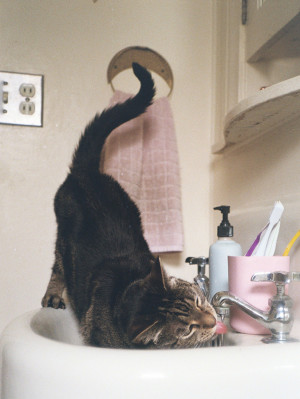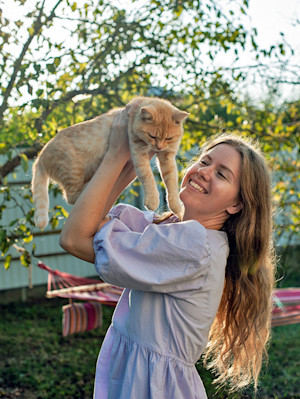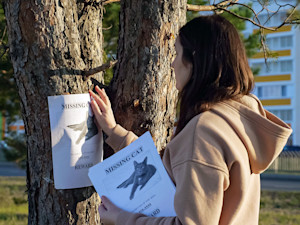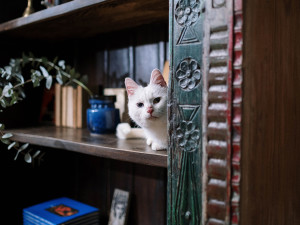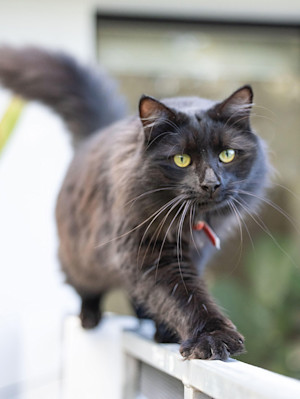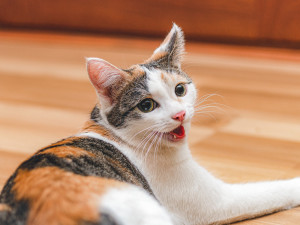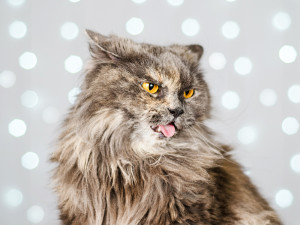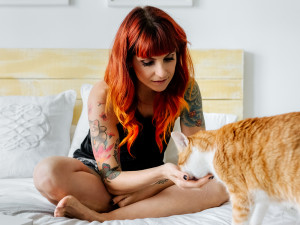How to Keep Your Cat Cool and Prevent Heat-Stroke
Summer safety is vital for cats
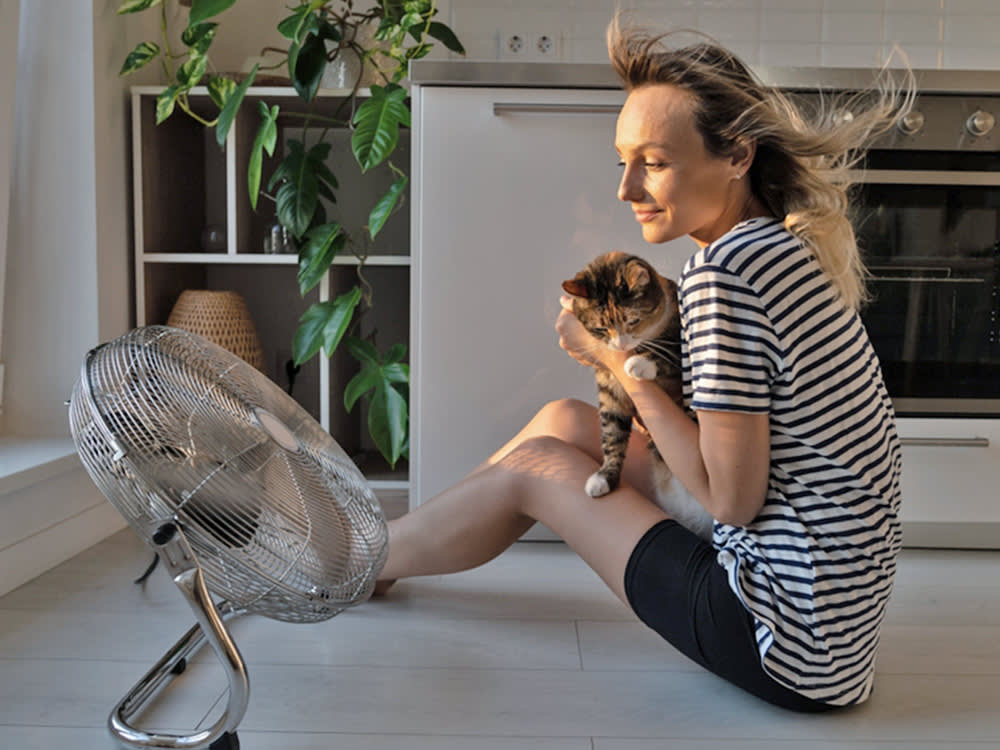
Share Article
With summer (potentially) approaching and the news filled with warnings of impending heatwaves, it’s important to ensure your cat stays cool for their health and comfort. Although cats were domesticated from desert species on warmer continents like Asia and Africa and do enjoy sunshine and heat (if you have a cat who always seeks out sun puddles, you’ll know what we mean), too much sun or heat exposure can lead to serious problems such as heat-stroke or even sunburn. Discover our tips on how to keep your kitty cool this summer.
How hot is too hot for cats?
Some cats love the sun and can generally cope with hot weather better than dogs. But a temperature above 37C is too hot for cats and they will generally prefer a temperature of around 25C. Any hotter than this and your cat can start to run the risk of overheating and may develop heat-stroke.

littleKin™ is Kinship’s home just for puppy and kitten parents. Bop over to check out expert advice, new pet tools, and special deals—all curated for your newest family member.
opens in a new tabWhat is heat-stroke in cats?
Heat-stroke is a state of hyperthermia (elevated core body temperature above the normal range) resulting in heat injury to tissues. Heat-stroke occursopens in a new tab when heat generation exceeds your cat’s ability to lose heat. Heat-stroke is a very serious and life-threatening conditionopens in a new tab that can cause damage to your cat’s internal organs. It requires urgent veterinary treatment. There are a number of signs of heat-stroke and you should contact your vet immediately if you spot them.
Pantingopens in a new tab: while cats don’t use panting to cool off in the same way that dogs do, if your cat’s mouth is open, tongue slightly out, and they’re taking short, shallow, audible breaths, this qualifies as panting for cats and can be a sign that they are overheating.
Droolingopens in a new tab: although cats drool for many reasons, which can range from pleasure to illness, if your cat is drooling in hot temperatures it can be a sign of heat exhaustionopens in a new tab as their bodies become overheated and unable to regulate their temperature.
Drinking a lot more wateropens in a new tab than usual: cats are notoriously not huge fans of lapping up large quantities of water from their bowl, so if you see this change of behaviour in your cat it could be a sign that they are too hot or suffering from heat-stroke.
You should also look out for:
body temperature over 40C
fast heartbeat
dark red or gums or tongue
restlessness
vomitingopens in a new tab and/or diarrhoeaopens in a new tab
muscle tremors
lethargy
dizziness and staggering
sweaty paws
collapsing and lying down
little to no urine production
coma
Which cats are more at risk of heat-stroke?
Some cats are more at risk of heat-stroke than others, these include:
senior cats
flat-faced breeds such as Persians or Himalayans
long-haired breeds such as Maine Coon or Ragdolls
cats with existing respiratory or heart disease
What to do if you think your cat has heat-stroke
If you suspect your cat has heat-stroke, contact your vet immediately. Initial emergency treatment at home should aim to normalise body temperature before you get to the vet. There are a few ways to do this:
Remove your cat from the hot environment immediately if possible.
Apply or spray tepid/cool water on to your cat’s fur and skin. Then fan them to maximise heat loss. Don’t use ice-cold water or ice as this may worsen the problem.
Then take your cat to the nearest veterinarian immediately.
Even if your cat looks like they may be recovering or you just suspect they might have heat-stroke, they should still always be checked by a vet.
Ways to keep your cat cool and prevent heat-stroke
Cats are usually very smart about what they need to do to cool off in hot weather. They might seek out cold, tiled surfaces to lie on; groom themselves (after licking their fur, the saliva then evaporates and will cool them down, in exactly the same way sweating cools us down); drink more water to stay hydrated; and take more naps – cats know that they need to save their energy when the weather is hot so during the hottest part of the day you may find that your cat is snoozing in a cool spot in your home.
There are lots of ways you can lend a helping hand to ensure your cat stays cool and does not develop heat-stroke.
Avoid heat and provide shade
Keep your house as cool and well ventilated as possible. If you have the space, you can also create a dedicated ‘cool room’ for your cat where you have drawn the curtains and created ventilation with fans and an open window. Just make sure the window is secured with a screen or netting so you cat doesn’t head out into the heat.
Keep your cat inside – preferably in that aforementioned well-ventilated space rather than in a room that typically gets hot – during the hottest part of the day (between 11am–3pm) so they are not exposed to direct sunlight and they’re not making contact with hot pavement or any other areas where heat is reflected and there is no access to shade. If your cat does go outside in the cooler hours of the day, it’s important to ensure they still have access to a shady spot.
You should also make sure your cat stays out of greenhouses, conservatories, sheds, porches and cars in warm weather as these locations are likely to heat up more. Always check before you close hot rooms – if your cat is trapped with nowhere to cool down, it’s likely to result in a serious case of heat-stroke.
Keep them hydrated
Make sure your cat has plenty of fresh clean drinking water, both indoors and outdoors, at all times and that the water bowl is in a shady spot. Some cats prefer to drink from running water, so try offering them a drink from your tap or a water fountainopens in a new tab to encourage them. You can also put ice cubes in their water bowl to keep it cooler.
Frozen treats
Ice lollies are a great way to keep your cat entertained and cool, just freeze some spring water from a can of tuna into an ice lolly mould. You can also put ice cubes on a hard floor for your cat to push around and play with (especially helpful if you have a bored kitty on your hands who can’t go outside because it’s too hot). This will help cool their paws, which is where cats absorb and lose heat.
Cooling devices
Cooling matopens in a new tab sopens in a new tab are a relatively cheap solution to help your cat stay cool. They are filled with a non-toxic gel that absorbs and dissipates your cat’s body heat. They don’t require electricity and can be recharged by allowing them to rest in a cool area.
Grooming
Grooming your cat’s excess fur can help them stay cool as fur traps heat. While your cat will do a lot of their grooming themselves, you can help by groomingopens in a new tab them daily to remove dead hair, which will make them feel more comfortable during a heatwave. On particularly hot days, you can also consider stroking your pet with wet hands to provide relief from the heat.
Use sunscreen
Although fur is a great sun barrier, cats can still get sunburnt especially on areas such as the ears and nose. Cats that are hairless, such as Sphynx cats, or light in colour such as ginger or white cats, are especially at risk. Arm yourself with some cat sunscreenopens in a new tab if your cat falls in to any of those categories and they’re going to be outside, even if it’s during cooler times of the day.
So while it may not be a hot girl summer for your feline, keeping your cat cool is extremely important for their health. But with a cool mat, an ice cube tray and knowledge of how to spot heat-stroke, you should be able to make the season a breeze for you and your kitty.
Ro Elfberg
Ro is Kinship UK’s Senior Editor. She has previously written and copy-edited for British Vogue, Glamour and DICE. When she’s not being manipulated into dishing out Dreamies to Kobe the cat, she spends her free time trying to convince her snake, Butters, to wear a tiny hat.
Related articles
- opens in a new tab
Why Is My Cat Hiding?
No, they’re not on the lam. Here are four reasons your cat might be MIA
![A fluffy black cat walking along the top of a fence.]() opens in a new tab
opens in a new tabWhy Cats Are So Good At Obstacle Courses, According To Science
Walk this way...
![kitten lying on the floor breathing through his mouth]() opens in a new tab
opens in a new tabIs My Cat... Panting?
“Cats don’t pant to cool off like dogs do.” Unless your pet is catching their breath after doing the zoomies, Dr Gary Weitzman says panting could be cause for concern
![grey and white cat with tongue sticking out]() opens in a new tab
opens in a new tabWhy Is Your Cat Vomiting Like They Partied All Night?
Here’s when you should worry if your cat is throwing up
![cat getting a vaccine at the vet]() opens in a new tab
opens in a new tabYep, Kittens Need Vaccines (Even Indoor Ones)
A vet gets the facts straight
![Young modern woman with tattoos and orange hair sitting cross-legged on her bed with her cat]() opens in a new tab
opens in a new tabDoes My Cat Really Need to See a Vet?
Cats can be hard to read. Especially when they’re sick. Or… not sick? We asked a veterinarian how to tell
